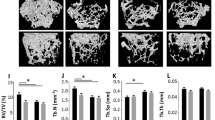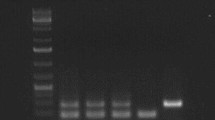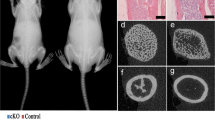Abstract
Lysyl oxidase (LOX) catalyzes cross-linking of elastin and collagen, which is essential for the structural integrity and function of bone tissue. The present study examined the role of Lox gene deficiency for the osteoblast phenotype in primary calvarial osteoblasts from E18.5 Lox knockout (Lox −/−) and wild type (wt) (C57BL/6) mice. Next to Lox gene depletion, mRNA expression of Lox isoforms, LOXL1–4, was significantly downregulated in Lox −/− bone tissue. A significant decrease of DNA synthesis of Lox −/− osteoblasts compared to wt was found. Early stages of osteoblastic apoptosis studied by annexin-V binding as well as later stages of DNA fragmentation were not affected. However, mineral nodule formation and osteoblastic differentiation were markedly decreased, as revealed by significant downregulation of osteoblastic markers, type I collagen, bone sialoprotein, and Runx2/Cbfa1.







Similar content being viewed by others
References
Boskey AL (1996) Matrix protein and mineralization: an overview. Connect Tissue Res 35:357–363
Fratzl P, Gupta HS, Paschalis EP, Roschger P (2004) Structure and mechanical quality of the collagen-mineral nano-composite in bone. J Mater Chem 14:2115–2123
Kagan H, Trackman P (1991) Properties and function of lysyl oxidase. Am J Respir Cell Mol Biol 5:206–210
Prockop D, Kivirikko K (1995) Collagens: molecular biology, diseases, and potentials for therapy. Annu Rev Biochem 64:403–434
Yamauchi M (1996) Collagen: the major matrix molecule in mineralized tissues. In: Anderson JJB, Garner S (eds) Calcium and phosphorus in health and disease. CRC Press, New York, pp 127–141
Knott L, Bailey A (1998) Collagen cross-links in mineralizing tissues: a review of their chemistry, function, and clinical relevance. Bone 22:181–187
Kagan H (1986) Biology and regulation of extracellular matrix: a series. In: Mecham RP (ed) Regulation of matrix accumulation, vol 1. Academic Press, Orlando, pp 321–398
Mäki JM, Kivirikko KI (2001) Cloning and characterization of a fourth human lysyl oxidase isoenzyme. J Biochem 355:381–387
Mäki JM, Tikkanen H, Kivirikko KI (2001) Cloning and characterization of a fifth human lysyl oxidase isoenzyme: the third member of the lysyl oxidase-related subfamily with four scavenger receptor cysteine-rich domains. Matrix Biol 20:493–496
Kenyon K, Modi WS, Contente S, Friedman RM (1993) A novel human cDNA with a predicted protein similar to lysyl oxidase maps to chromosome 15q24–q25. J Biol Chem 268:18435–18437
Ito H, Akiyama H, Iguchi H, Iyama K, Miyamoto M, Ohsawa K et al (2001) Molecular cloning and biological activity of a novel lysyl oxidase-related gene expressed in cartilage. J Biol Chem 276:24023–24029
Jourdan-Le Saux C, Le Saux O, Donlon T, Boyd CD, Csiszar K (1998) The human lysyl oxidase-related gene (LOXL2) maps between markers D8S280 and D8S278 on chromosome 8p21.2–p21.3. Genomics 51:305–307
Huang Y, Dai J, Tang R, Zhao W, Zhou Z, Wang W et al (2001) Cloning and characterization of a human lysyl oxidase-like 3 gene (hLOXL3). Matrix Biol 20:153–157
Borel A, Eichenberger D, Farjanel J, Kessler E, Gleyzal C, Hulmes DJ et al (2001) Lysyl oxidase-like protein from bovine aorta. Isolation and maturation to an active form by bone morphogenetic protein-1. J Biol Chem 276:48944–48949
Kim MS, Kim SS, Jung ST, Park JY, Yoon HW, Ko J et al (2003) Expression and purification of enzymatically active forms of the human lysyl oxidase-like protein 4. J Biol Chem 278:52071–52074
Knott L, Whitehead C, Fleming R, Bailey A (1995) Biochemical changes in the collagenous matrix of osteoporotic avian bone. J Biochem 310:1045–1051
Eyre DR, Dickson IR, Van Ness K (1988) Collagen crosslinking in human bone and articular cartilage: age-related changes in the content of mature hydroxypyridinium residues. J Biochem 252:495–500
Geiger BJ, Steenbock H, Parsons HT (1933) Lathyrism in the rat. J Nutr 6:427–442
Shim H, Harris ZL (2003) Genetic defects in copper metabolism. J Nutr 133:1527S–1531S
Uzel M, Scott I, Babakhanlou-Chase H, Palamakumbura A, Pappano W, Hong H et al (2001) Multiple bone morphogenic protein-1 related mammal metalloproteinases process pro-lysyl oxidase at the correct physiological site and control lysyl oxidase activation in mouse embryo fibroblast cultures. J Biol Chem 276:22537–22543
Guo Y, Pischon N, Palamakumbura AH, Trackman P (2007) Intracellular distribution of the lysyl oxidase propeptide in osteoblastic cells. Am J Physiol Cell Physiol 292:2095–2102
Nellaiappan K, Risitano A, Liu G, Nicklas G, Kagan H (2000) Fully processed lysyl oxidase catalyst translocates from the extracellular space into nuclei of aortic smooth-muscle cells. J Biol Chem 79:576–582
Li W, Nellaiappan K, Strassmaier T, Graham L, Thomas K, Kagan H (1997) Localization and activity of lysyl oxidase within nuclei of fibrogenic cells. Proc Natl Acad Sci USA 94:12817–12822
Palamakumbura A, Jeay S, Guo Y, Pischon N, Sommer P, Sonenshein G et al (2004) The propeptide domain of lysyl oxidase induces phenotypic reversion of ras-transformed cells. J Biol Chem 279:40593–40600
Jeay S, Pianetti S, Kagan H, Ge S (2003) Lysyl oxidase inhibits ras-mediated transformation by preventing activation of NF-kappa B. Mol Cell Biol 23:2251–2263
Giampuzzi M, Oleggini R, Di Donato A (2003) Demonstration of in vitro interaction between tumor suppressor lysyl oxidase and histones H1 and H2: definition of the regions involved. Biochim Biophys Acta 1647:245–251
Min C, Kirsch KH, Zhao Y, Jeay S, Palamakumbura AH, Trackman PC et al (2007) The tumor suppressor activity of the lysyl oxidase propeptide reverses the invasive phenotype of Her-2/neu-driven breast cancer. Cancer Res 67:1105–1112
Wu M, Min C, Wang X, Yu Z, Kirsch K, Trackman PC et al (2007) Repression of BCL2 by the tumor suppressor activity of the lysyl oxidase propeptide inhibits transformed phenotype of lung and pancreatic cancer cells. Cancer Res 67:6278–6285
Hong HH, Pischon N, Santana RB, Palamakumbura AH, Chase HB, Gantz D et al (2004) A role for lysyl oxidase regulation in the control of normal collagen deposition in differentiating osteoblast cultures. J Cell Physiol 200:53–62
Mäki JM, Räsänen J, Tikkanen H, Sormunen R, Mäkikallio K, Kivirikko KI et al (2002) Inactivation of the lysyl oxidase gene Lox leads to aortic aneurysms, cardiovascular dysfunction, and perinatal death in mice. Circulation 106:2503–2509
Hornstra I, Birge S, Starcher B, Bailey A, Mecham R, Shapiro S (2003) Lysyl oxidase is required for vascular and diaphragmatic development in mice. J Biol Chem 278:14387–14393
Mäki J, Sormunen R, Lippo S, Kaarteenaho-Wiik R, Soininen R, Myllyharju J (2005) Lysyl oxidase is essential for normal development and function of the respiratory system and for the integrity of elastic and collagen fibers in various tissues. Am J Pathol 167:927–936
Radlanski RJ, Renz H, Klarkowski MC (2003) Prenatal development of the human mandible. 3D reconstructions, morphometry and bone remodelling pattern, sizes 12–117 mm CRL. Anat Embryol 207:221–232
Bellows CG, Aubin JE, Heersche JNM, Antosz ME (1986) Mineralized bone nodules formed in vitro from enzymatically released rat calvaria cell populations. Calcif Tissue Int 38:143–154
Ecarot-Charrier B, Glorieux FH, Van der Rest M, Pereira G (1983) Osteoblasts isolated from mouse calvaria initiate matrix mineralization in culture. J Cell Biol 96:639–643
Hippenstiel S, Schmeck B, N’Guessan PD, Seybold J, Krull M, Preissner K et al (2002) Rho protein inactivation induced apoptosis of cultured human endothelial cells. Am J Physiol Lung Cell Mol Physiol 283:L830–L838
N’Guessan PD, Vigelahn M, Bachmann S, Zabel S, Opitz B, Schmeck B et al (2007) The UspA1 protein of Moraxella catarrhalis induces CEACAM-1-dependent apoptosis in alveolar epithelial cells. J Infect Dis 195:1651–1660
N’Guessan PD, Schmeck B, Ayim A, Hocke AC, Brell B, Hammerschmidt S et al (2005) Streptococcus pneumoniae R6x induced p38 MAPK and JNK-mediated caspase-dependent apoptosis in human endothelial cells. Thromb Haemost 94:295–303
Livak KJ, Schnmittgen TD (2001) Analysis of relative gene expression data using real-time quantitative PCR and the 2-∆∆C(T) method. Methods Enzymol 25:402–408
Stein G, Lian J, Stein J, Van Wijnen J, Montecino M (1996) Transcriptional control of osteoblast growth and differentiation. Physiol Rev 76:593–629
Atsawasuwan P, Mochida Y, Parisuthiman D, Yamauchi M (2005) Expression of lysyl oxidase isoforms in MC3T3–E1 osteoblastic cells. Biochem Biophys Res Commun 327:1042–1046
Pischon N, Darbois LM, Palamakumbura AH, Kessler E, Trackman PC (2004) Regulation of collagen deposition and lysyl oxidase by tumor necrosis factor-alpha in osteoblasts. J Biol Chem 279:30060–30065
Turecek C, Fratzl-Zelman N, Rumpler M, Buchinger B, Spitzer S, Zoehrer R et al (2008) Collagen cross-linking influences osteoblastic differentiation. Calcif Tissue Int 82:392–400
Jordan MA (2002) Mechanism of action of antitumor drugs that interacts with microtubules and tubulin. Curr Med Chem Anti-Cancer Agents 2:1–17
Hock JM, Krishnan V, Onyia JE, Bidwell JP, Milas J, Stanislaus D (2001) Osteoblast apoptosis and bone turnover. J Bone Miner Res 16:975–984
Ducy P, Zhang R, Geoffroy V, Ridall AL, Karsenty G (1997) Osf2/Cbfa1: a transcriptional activator of osteoblast differentiation. Cell 89:747–754
Acknowledgements
We thank B. Danielowski and V. Kanitz for the technical support in the laboratory. This study was supported by grant DE140066 (to P. T.), grants 202469 from the Health Science Council and the S. Juselius Foundation (to J. M.), research stipend German Research Foundation GK-325-00 (to P.M. and N.H.), as well as short-term research fellowships from European Molecular Biology Organization and European Cooperation in Science and Technology, a habilitation stipend from the Charité – Universitätsmedizin Berlin, and research grant DFG PI 420/3 (to N.P.).
Author information
Authors and Affiliations
Corresponding author
Rights and permissions
About this article
Cite this article
Pischon, N., Mäki, J.M., Weisshaupt, P. et al. Lysyl Oxidase (Lox) Gene Deficiency Affects Osteoblastic Phenotype. Calcif Tissue Int 85, 119–126 (2009). https://doi.org/10.1007/s00223-009-9252-8
Received:
Accepted:
Published:
Issue Date:
DOI: https://doi.org/10.1007/s00223-009-9252-8




